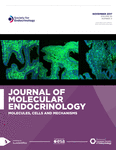Alternative splicing of the proadrenomedullin gene results in differential expression of gene products
Abstract
The adrenomedullin (AM) gene codifies for two bioactive peptides, AM and proAM N-terminal 20 peptide (PAMP). We have found two forms of the AM mRNA. Form A is devoid of introns and results in a prohormone containing both peptides. Form B retains the third intron, which introduces a premature stop codon, producing a shorter prohormone with only PAMP. Tissues with a higher B/A ratio were more immunoreactive for PAMP than for AM. The form B message was found in the cytoplasmic compartment, thus excluding that the longer message was a result of contaminating nuclear mRNA. Form B was found in cells that express PAMP but not AM. mRNA expression in a variety of cell lines was investigated by ribonuclease protection assay and form B was found in significant amounts in two of them. Treatments that modify AM expression, such as exposure to hypoxia, were shown to change the B/A ratio and the relative secretion of AM and PAMP, indicating that the splicing mechanism for AM can be modulated and is physiologically relevant. Analysis of the sequence of the third intron and the fourth exon of the AM gene found motifs compatible with a highly regulated alternative splicing mechanism.











